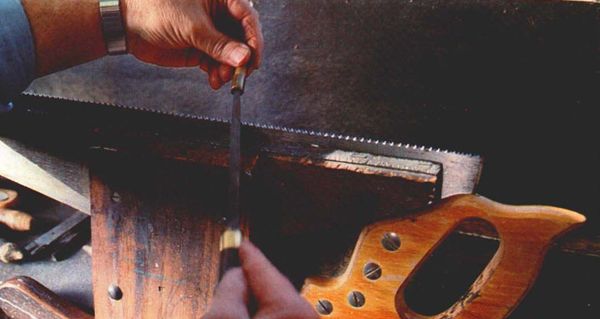
Synopsis: Harold H. Payson remembers a time before circular saws, when the handsaw that cut fast and true to the line without biding or rattling in its kerf was admired and remembered. Properly sharpened handsaws make short work of most cutting tasks; improperly sharpened, they’re drudgery to use. Here he explains how to remedy a saw’s problems: he outlines the basic process of sharpening and then details how to do it. He uses a filing bench and a filing vise to hold the saw properly, and he uses a sawtooth jointer and saw set. He clarifies the differences between sharpening crosscut saws and ripsaws, and he shares tips on troubleshooting a saw. Side information by Henry T. Kramer explains how to use handsaws.
Years ago, a visitor to my father’s shop in Rockland, Me., spying the half-dozen or so heavily chewed file handles sitting on his filing bench, paused his conversation for a moment and asked, “You got rats?”
No, my father, Herman W. Payson, didn’t have rats in his shop. What he had was the best reputation around for sharpening saws of any kind, especially handsaws—an honor not to be taken light ly. Many of the best ship and house carpenters in our area brought their handsaws to him and returned faithfully, time and time again. The handles on his files were chewed up not from rats, but from years of being lightly “thunked” on freshly sharpened sawteeth to remove the burr left by the file. If removal of the burr showed a tooth not brought up to a sharpened point, then that tooth received another swipe or two with the file until it did.
My dad’s heyday was back in the 1930s, in the era before circular saws replaced handsaws as the common tool for cutting lumber on the construction site and shipyard. The handsaw that cut fast and true to the line without binding or rattling in its kerf was much admired and well remembered. Handsaws aren’t as widely used as they once were, but that’s no excuse for using a dull one or not knowing how to sharpen one properly. A properly sharpened handsaw is handy for jobs where a circular saw is dangerous or just unwieldily to use. If sharpened correctly, they make short work of most cutting tasks; improperly sharpened, they’re drudgery to use.
Learning how to sharpen a handsaw isn’t difficult, just time consuming. My father developed his reputation for sharpening handsaws over many years, and it took me a year of practice filing before he squinted down the teeth of my best efforts and declared, “That’s as good as I can do.” Words I never thought I’d hear. Was it worth it? You bet.
It’s rewarding to know that I can remedy a saw’s problems rayself with little fuss or lost time. I’ll never have to put up with lame excuses from a saw-sharpening shop that they can’t get around to sharpening a saw until next week. True, I can’t match the precision of a saw-filing machine, but why should I ? Small variations between teeth don’t detract from a saw’s cutting ability. A machine-sharpened saw does the job, but a saw sharpened by hand is a pleasure to use.
The problem with saw-filing machines (at least the ones I’m familiar with) is that each tooth is sharpened based on the profile of the tooth ahead of it. A dogged lever drops over each tooth and pulls the saw into position for a swipe of a file. If the saw was newly re-toothed and the teeth perfect, a machine does fairly well. But teeth damaged after hitting nails throw the machine off.
From Fine Woodworking #68
For the full article, download the PDF below:
Fine Woodworking Recommended Products

Honing Compound

Starrett 12-in. combination square

Norton Water Stones






















Comments
The text in the article is a bit scrambled.
Log in or create an account to post a comment.
Sign up Log in